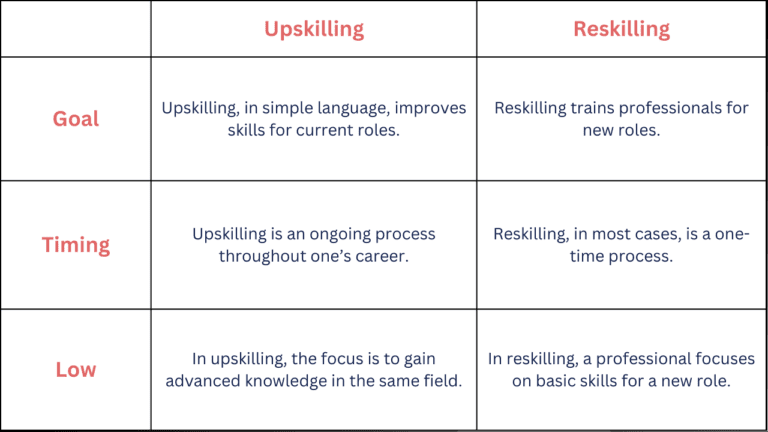Upskilling vs Reskilling: What’s Best for Your Workforce?
December 27, 2024


If you are reading this, you already know how fast all workplaces are changing these days. Technology, market demands, and employee needs are evolving every passing hour. If you want to stay competitive, you must find ways to keep your workforce skilled and productive. And, this is where upskilling and reskilling come in.
But which is right for your team? Let’s help you get a clear answer to this.
What Are Upskilling and Reskilling?
Upskilling means helping employees learn new skills to do their current jobs better. For example, a marketing employee might learn new sales techniques or new digital tools. Whoever the professional is, the goal is always to improve existing skills to meet current demands.
The next on the list is reskilling which is all about training employees for new roles. For example, a factory worker may learn robotics and become a robotics technician. Reskilling is needed when roles become outdated or companies shift direction.
Remember, both are important. The choice depends on what your organisation and employees need.
Upskilling vs Reskilling: What’s the Difference?


If you understand these differences well, you can decide the best approach for your team.
Why Upskilling and Reskilling Are Important
Let’s keep the upskilling vs reskilling part aside and understand why both of these are extremely important.
Technology:
Automation and artificial intelligence (AI) are developing at an all-time high rate and they are changing industries. It’s a must for employees to acquire new skills to keep up.
Skill Gaps:
Talking about skills, many industries are reporting a shortage of skilled workers. Upskilling and reskilling are two of the most important factors that can fill these gaps.
Retention:
Who doesn’t want growth opportunities? You, as an employer, can promote training programs for employees to improve retention and even loyalty.
Cost Efficiency:
If you were in a management role, you would know how expensive hiring new employees is. So. train existing staff, help them upskill or reskill and save time and money.
Benefits of Upskilling
- Higher Productivity: Skilled employees work faster and deliver better results, without a doubt.
- Career Growth: Employees who always focus on upskilling, witness consistent career growth and are more satisfied.
- Adaptability: A skilled team can, any day, face challenges and seize opportunities.
- Stronger Leadership: Even employees, when they possess the right skills, come out as strong leaders.
Benefits of Reskilling
Reskilling is as valuable as upskilling; even more so during big changes.
Flexibility: Reskilled employees can move into new roles, with ease. This helps reduce layoffs and also results in smooth operations.
Innovation: Whenever an employee enters a new role, they bring fresh ideas and creativity.
Future-Readiness: Professionals who focus on reskilling show that they are ready for future opportunities. This aspect not only helps them but also the businesses they are involved in.
When to Choose Upskilling or Reskilling
The decision depends on these factors:
Industry Trends:
If changes are slow, upskilling may be enough. If roles are disappearing or being replaced, reskilling is needed.
Skills Gaps:
Analyse your team’s current skills and then decide whether they align with their roles or need a shift.
Business Goals:
Are you looking to improve current operations or are you trying to enter new markets? If you have an answer to this, you know which strategy to go for.
Employee Input:
Be with your team, understand what they want. This can help you in determining the better of the two for each of your team members.
Technology Changes:
Mark this down, if technology or AI impacts your industry to a great deal, reskilling is a must.
How to Implement Upskilling and Reskilling
Assess Skills:
First of all, find out what your team knows now and what they need to learn.
Use Technology:
Use AI tools, e-learning platforms, and virtual reality training. These can make training easier and more impactful.
Provide Practice:
Just training is not enough. You also need to give your team real-world projects, mentorship, and job shadowing to apply new skills.
Track Results:
Performance reviews, feedback, and business outcomes can help you determine whether the approach is working well or not.
Create a Culture of Learning:
Build a culture of continuous learning through workshops, online courses, and even team discussions.
Trends Increasing Upskilling and Reskilling
AI and Automation: As machines handle routine tasks, employees need creativity and problem-solving skills.
Sustainability: Companies are training workers in green practices and environmental skills.
Digital Skills: Cloud computing, cybersecurity, and blockchain are popular training areas.
Remote Work: Remort work is in trend now and hence, Every employee should learn virtual collaboration and digital leadership skills.
Diversity and Inclusion: Every training program, these days, is created with a direct or indirect intent toward building inclusive workplaces.
Soft Skills: Leadership, communication, and emotional intelligence are in high demand across all industries.
Combining Upskilling and Reskilling
How about upskilling + reskilling instead of upskilling vs reskilling? Yes, a strong workforce strategy blends both approaches. The first helps employees enhance their skills in their current roles. While the latter opens new gates for people whose roles are changing or getting outdated. So, how can combine them?
Assess Current and Future Needs
Evaluate new and changing industry trends and business goals almost every day. After that, try to figure out both immediate and long-term skill requirements. This will help you to balance the process of improving existing capabilities with training for new challenges.
Create Flexible Learning Paths
Design programmes that cater to individual career goals too. For example, an employee interested in leadership can be upskilled in management skills. On the other hand, if someone wants to shift departments, they can undergo reskilling.
Use Integrated Training Tools
Invest in platforms that offer resources for both upskilling and reskilling. Again, as we mentioned above, you can go for AI tools, personalised courses, and even interactive simulations for different ways of learning.
Monitor Progress and Adapt
Combine frequent feedback with performance metrics to find out the impact of your training initiatives. Also, be ready to adjust strategies based on changing employee or organisational needs.
Remember, by using upskilling and reskilling together, businesses can tackle both current and future challenges.
The Road Ahead: Building a Learning Organisation
You cannot even think of growth if you don’t prioritise continuous education and innovation opportunities. This means you need to remodel your business into a learning organisation. How can you do it? Let’s help you out.
Promote a Growth Mindset:
Encourage employees to look at challenges as opportunities to learn and grow. Celebrate efforts and progress and not just results.
Leadership Involvement:
Lead by example, they say. Leaders should walk the path themselves first and participate in different training programs. This motivates employees to take learning seriously.
Collaborate with Experts:
Take help from industry leaders, educational institutions, and tech providers to design effective training content according to your workforce.
Reward Learning:
Recognise and reward employees who are involved in upskilling or reskilling activities. The rewards can be certifications, promotions, or public acknowledgement.
Stay Ahead of Trends:
Align with new technologies and industry requirements and keep updating your training programs according to the same.
Remember, when you build a culture of learning, you don’t only adapt to changes but thrive in uncertainty. Employees become more efficient, company’s goals are met— a win-win situation for all.
Conclusion
If you are looking for one pick from upskilling vs reskilling, there’s no definite answer. The choice depends on your business needs and employee goals. When you invest in both, in the right way, you move towards learning, growth, and success.
Always remember that the goal is not just to keep up but to stay ahead. With the right training, your workforce can become your greatest asset in this highly competitive world.
Upskilling and reskilling are not just strategies; they are investments in your team’s future.
So, when are you finalising your next upskilling or reskilling approach?
Related Stories


How Important is Empathy in Leadership
Learn the importance of empathy in leadership and how it can enhance your team’s performance. Know the challenges and how to overcome them.


How to Overcome Leadership Challenges: Proven Tips & Strategies
Overcome every challenge in leadership with these proven strategies. Enhance communication, boost team morale, and lead with confidence and clarity.


How to Overcome Imposter Syndrome as a Leader?
How to Overcome Imposter Syndrome as a Leader


Why is POSH Training Essential for Organisations
The importance of conducting POSH Training sessions in your organisation and how it can create a safe work environment.


Promoting LGBTQ Inclusion in the Modern Workplace
Discover the importance of LGBTQ inclusion in fostering diversity, equity, and acceptance. Explore strategies for creating inclusive spaces.


How POSH Training Shapes a Harassment-Free Workplace for Your Organisation
Know what is POSH training and how can POSH training for employees help them. Know why POSH training a priority for every organisation.
